Few stories in baseball history have cast a longer or darker shadow than the 1919 Black Sox Scandal, when eight members of the Chicago White Sox were accused of conspiring to throw the World Series. Despite – or perhaps because of – the scandal, interest in the players involved has endured for over a century. For collectors, Black Sox baseball cards offer a unique intersection of sports lore and cardboard history, capturing a moment when baseball’s integrity was deeply tested.
Collecting Black Sox baseball cards is unlike chasing modern rookies or Hall of Fame legends. Since collecting baseball cards was not yet a mainstream hobby, many of the key figures appear on pre-war tobacco cards and early caramel issues. This makes them both historically important and often expensive. The scarcity and mystique surrounding these cards only deepen their appeal. Whether you’re drawn by the rarity, the players’ on-field greatness, or the scandal that defined their legacy, Black Sox baseball cards represent a fascinating niche for collectors who appreciate the complex layers of the game’s past.
The 1919 Chicago Black Sox Scandal
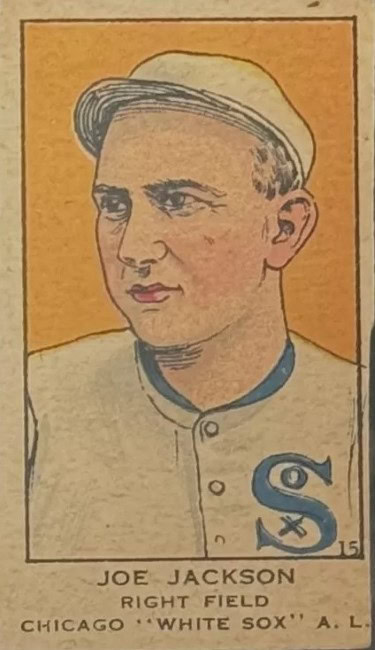
The Black Sox Scandal unfolded after eight players from the Chicago White Sox conspired with gamblers to fix the 1919 World Series. Many of the players were frustrated by poor salaries, harsh treatment from team owner Charles Comiskey, and a lack of control over their careers. Led by first baseman Chick Gandil, the group agreed to intentionally lose games in exchange for money. Pitcher Eddie Cicotte signaled the start of the fix by hitting the first batter of Game 1. Outfielder Shoeless Joe Jackson, one of the most famous names involved, later claimed he played to win, but evidence still linked him to the conspiracy.
Throughout the Series, the players made errors, pitched poorly, and showed a lack of effort. Some teammates outside the fix grew suspicious. By 1920, word of the scandal spread through the press, and a grand jury opened an investigation. The players confessed but later recanted. In 1921, a jury found them not guilty of criminal wrongdoing. However, baseball’s new commissioner, Kenesaw Mountain Landis, banned all eight men for life, citing the need to protect the game’s integrity. His ruling sent a clear message: gambling would not be tolerated.
The scandal damaged the public’s trust in baseball, which was still emerging as America’s pastime. It also led to major changes in how the sport governed itself:
- The role of commissioner was created to provide independent oversight.
- Gambling and match-fixing rules were strengthened.
- Team owners began paying more attention to player morale and public perception.
Though more than a century has passed, the Black Sox Scandal remains one of the darkest and most influential events in baseball history.
Black Sox Baseball Cards
Fred McMullin
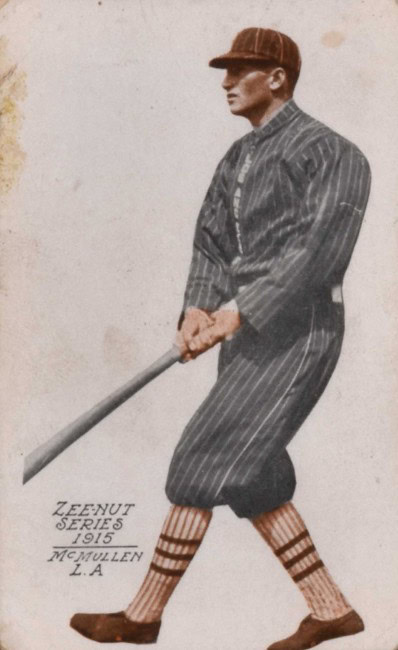
Fred McMullin was a utility infielder who played sparingly for the Chicago White Sox. Born in 1891 in Kansas, he bounced between minor league teams before landing a backup role in Chicago. Over three seasons, McMullin appeared in 89 games and posted a modest .256 career batting average. Though rarely in the spotlight, he earned a World Series ring with the 1917 championship team. By 1919, he had become a little-used bench player, better known for his clubhouse presence than his on-field impact.
McMullin was not an original conspirator in the 1919 World Series fix. He allegedly overheard conversations about the scheme and then demanded a cut in exchange for his silence. His role was opportunistic rather than strategic, but he still became one of the eight players banned for life. He appeared in all three of the White Sox’s wins during the Series, despite limited overall involvement.
After his ban, McMullin faded from the public eye. He worked as a carpenter and draftsman in Los Angeles. Unlike some of his former teammates, he never spoke publicly about the scandal or tried to re-enter the baseball world. He died in 1952, remembered mostly as a peripheral but still tainted figure in the Black Sox story.
As the least famous of the Black Sox, Fred McMullin baseball cards barely exist. He has one contemporaneous card, the 1915 Zeenut PCL minor league card, and even then, his name is misspelled. It sells for several thousand dollars, even in poor condition.
Happy Felsch
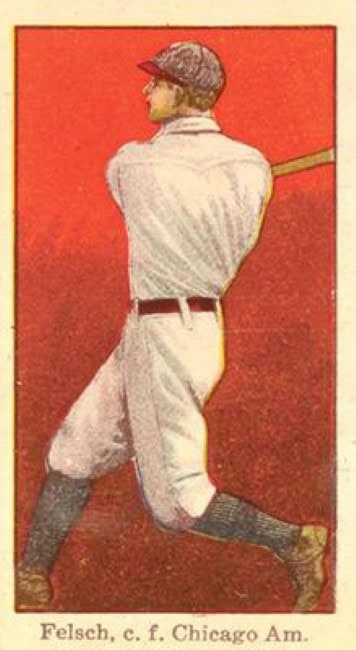
Oscar “Happy” Felsch was a talented center fielder with a powerful bat, a cannon arm, and a cheerful personality that earned him his nickname. Born in Milwaukee in 1891, he made his major league debut with the White Sox in 1915 and quickly became a crowd favorite. By 1919, he was one of the American League’s top outfielders. That season, he drove in 86 runs and hit .275, while anchoring the defense in center field.
Felsch played a major role in the Black Sox Scandal. He accepted $5,000 to help throw the World Series – one of the largest payoffs given. His performance in the Series dipped sharply. He made defensive errors and struggled at the plate, contributing to the team’s losses. Afterward, Felsch admitted to taking the money and expressed little regret, saying he made more from the fix than he would’ve earned playing clean.
Following his expulsion from baseball, Felsch returned to Milwaukee. He opened taverns, played semi-pro and outlaw ball, and remained a recognizable figure in his community. Though he never came back to professional baseball, he lived until 1964 and occasionally gave interviews. In them, he reflected on the scandal with a mix of pride for his playing days and acceptance of how things ended.
Like McMullin, Happy Felsch doesn’t have a lot of available baseball cards. His most interesting is the 1916 Mother’s Bread card; in a landscape filled with tobacco cards, this one is more wholesome. It features a swinging Felsch in front of a bright red background. You can find it in poor condition for around $1,000.
Swede Risberg
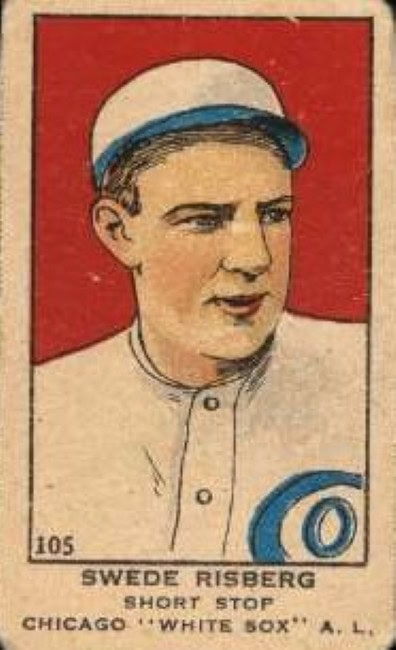
Charles “Swede” Risberg, born in San Francisco in 1894, broke into the majors as a sharp defensive shortstop. He had a strong arm and played with intensity, though his batting left much to be desired. Risberg became the White Sox’s starting shortstop in 1917 and held that spot through the infamous 1919 season. He earned a reputation as tough, fearless, and loyal to his teammates.
Risberg was deeply involved in the plot to throw the World Series. Along with Chick Gandil, he helped organize the fix and acted as a go-between for players and gamblers. He was reportedly paid $15,000 – a huge sum compared to his regular salary. During the Series, he performed poorly, both offensively and defensively, further implicating him in the scandal.
After receiving a lifetime ban, Risberg played semi-pro and outlaw baseball for years. He eventually moved to northern California, where he ran a tavern and a meat business. In the 1940s, he testified in court about baseball’s business practices, still bitter toward the sport’s leadership. Risberg died in 1975 as the last living Black Sox member, and never showed remorse for his role.
Swede Risberg is featured in the famous W514 strip cards, which have vibrant colors and sketches of each player. It’s also one of the first sets to explicitly number each card. These cards were hand-cut and, at over 100 years old, they’re hard to find in even fair condition. Finding an “Authentic” example will set you back around $300.
Buck Weaver
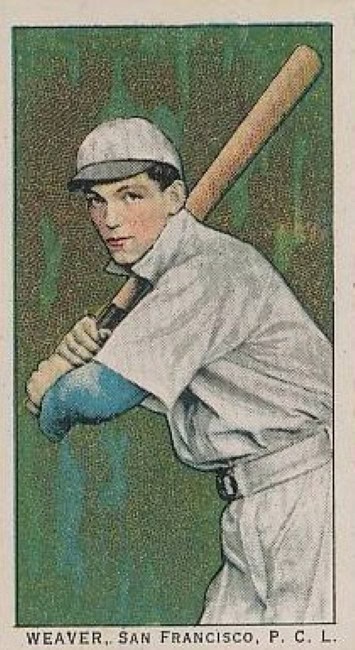
George “Buck” Weaver, born in 1890, was the White Sox’s regular third baseman and a fan favorite. Raised in Chicago, he joined the team in 1912 and became known for his hustle, sharp glove, and loyalty. In 1919, he hit .296 and played a key role in the infield. He was close friends with Shoeless Joe Jackson and well-liked by teammates.
Weaver’s case remains one of the most controversial aspects of the scandal. He never took any money, and his World Series performance – a .324 batting average and solid defense – showed no signs of foul play. However, he attended meetings about the fix and didn’t report what he knew. Commissioner Landis banned him for having “guilty knowledge.”
Weaver spent the rest of his life fighting to clear his name. He submitted multiple petitions for reinstatement, all of which were denied. He played semi-pro ball for a while, then worked in Chicago as a bartender and business owner. At one point he reportedly said: “There are murderers who serve a sentence and then get out. I got life.” Buck Weaver died in 1956, still banned and still hoping for redemption.
Weaver has several contemporaneous cards, but the 1911 T212 is an underrated option. It features a sketch of Weaver in his batting stance, and the layout mirrors other sets like the T206. One of these cards graded PSA 2 recently sold for $800.
Eddie Cicotte
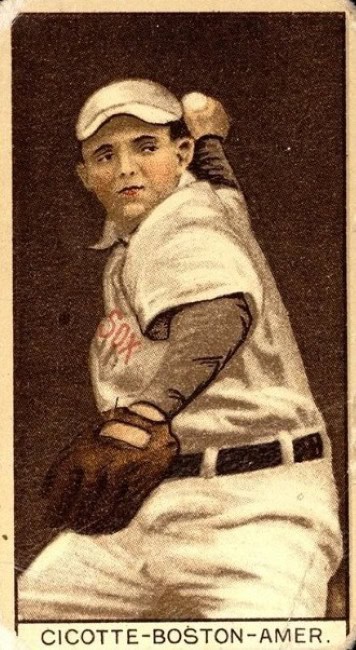
Eddie Cicotte, born in Detroit in 1884, was a right-handed pitcher known for his control, guile, and mastery of the knuckleball. He led the American League in wins and ERA in 1917 and helped the White Sox win the World Series that year. In 1919, Cicotte had another standout year, going 29-7 with a 1.82 ERA. He was the team’s ace and a leader on and off the field.
Cicotte agreed to help fix the Series after owner Charles Comiskey allegedly benched him to prevent him from earning a contract bonus. Frustrated, Cicotte accepted $10,000 and admitted to hitting the first batter of Game 1 to signal the fix. While he still pitched effectively in some games, his early actions implicated him as a key figure in the scandal.
After his ban, Cicotte returned to Michigan, where he lived quietly as a farmer and later worked for the Ford Motor Company. He rarely spoke publicly about the scandal. Cicotte died in 1969, having lived a long life far from the game that once made him famous.
Eddie Cicotte is featured in the T207 collection, which features some of the best art of the early 20th century. Compared with his better-known T206, we much prefer the T207. By virtue of its fame as a set, the T206 is about 50% more expensive than Cicotte’s T207, but either can be had for around $500 for low grades.
Chick Gandil
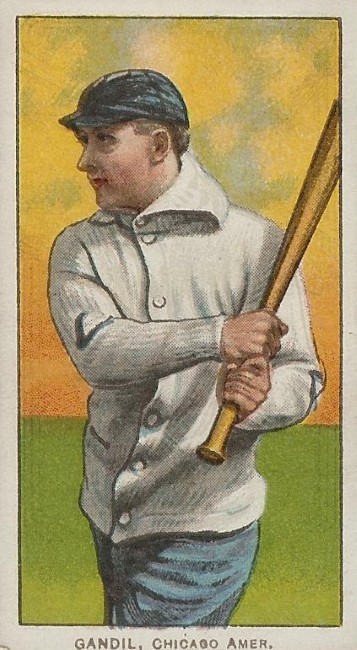
Arnold “Chick” Gandil, born in Minnesota in 1888, was a hard-nosed first baseman and the acknowledged leader of the 1919 fix. He played for several teams before landing with the White Sox and helped them win the 1917 title. In 1919, he hit .290 and acted as a veteran presence in the clubhouse.
Gandil organized the conspiracy and brought the players together. He made deals with gamblers and served as the operation’s coordinator. He reportedly took home over $35,000 – the largest payoff of anyone involved. His play during the Series was uninspiring, with a .233 batting average and average defense. When the scandal broke, Gandil quickly became the face of the fix.
After his lifetime ban, Gandil moved to California and worked in construction and plumbing. He played semi-pro ball for a short time and tried to put together a team with other banned or ostracized players, but mostly stayed out of the public eye. In 1956, he gave a lengthy interview to Sports Illustrated, offering his version of events. Many doubted its accuracy. Gandil died in 1970, his name forever tied to baseball’s darkest chapter.
Chick Gandil’s most famous card is his 1909-1911 T206. Although other Gandil cards exist, this is by far the moment popular and easiest to obtain on the open market. The card costs around $1,500-$3,000 in low-mid grades. Another great option for Gandil cards is the 1910 E90-3 American Caramel, which is priced around $5,000.
Lefty Williams

Claude “Lefty” Williams, born in Missouri in 1893, was a reliable left-handed pitcher who teamed with Cicotte to form one of the best duos in baseball. He began with the Tigers but found success with the White Sox. In 1919, he won 23 games and posted a 2.64 ERA. Williams was calm under pressure and known for his deceptive curveball.
He was paid $5,000 to participate in the fix and pitched poorly in the Series. Williams lost three games – still a World Series record. After Game 2, gamblers allegedly threatened his wife to ensure he stayed in line. His shaky outings became critical pieces of evidence during the investigation.
After being banned, Williams moved to Texas and later to California. He worked various jobs, including as a painter and hotel clerk. He played some outlaw baseball but eventually left the game behind. Williams died in 1959, regarded as one of the most tragic figures in the scandal.
Lefty Williams is featured in the W513 strip card set that predates the more famous W514 set, which features Swede Risberg and Joe Jackson. Williams’s card, like his teammates, is hand-cut and therefore difficult to find in decent condition. Still, it’s a beautiful card with vibrant coloring, and it’s usually available for $300-$500 in low grades.
“Shoeless” Joe Jackson
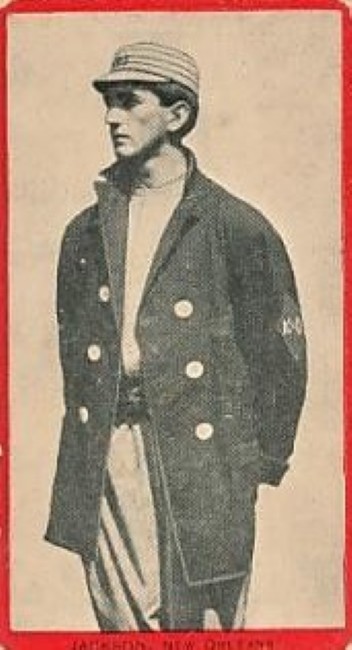
Joe Jackson, born in South Carolina in 1887, was one of the greatest hitters the game has ever seen. He began with the Athletics but made his name with the Cleveland Naps and Chicago White Sox. In 1911, he hit .408. Over his career, he maintained a .356 average – among the highest in history. Jackson’s smooth swing and fielding instincts made him a star.
His involvement in the scandal remains the subject of intense debate. He received $5,000, yet hit .375 in the Series, knocked in six runs, and didn’t commit a single error. Some say he tried to win; others point out he still accepted money and kept quiet. Jackson was banned along with the others, his talent overshadowed by the controversy.
After his ban, he played semi-pro ball under aliases and later ran a liquor store in South Carolina. Locally, he remained a beloved figure. Jackson died in 1951, still hoping baseball would restore his name. His legacy endures through books, films, and collectibles, especially his highly sought-after baseball cards.
Joe Jackson cards, more than any other 1919 Black Sox baseball cards, are highly collectible and command, at times, extreme prices. One of his rarest is the 1910 T210 “Shoeless” Joe Jackson, which features him with New Orleans in the Southern Association, the year before he debuted in the big leagues. PSA 1 and PSA 2 have sold for $50,000-$75,000.
Here are some other contemporaneous options:
- 1909 E90-1 American Caramel Joe Jackson, PSA 1: $30,000
- 1915 Cracker Jack Joe Jackson #103, PSA 1: $30,000
- 1916 M101-4 Sporting News Joe Jackson #87, PSA 2: $4,000
- 1919 W514 Joe Jackson strip card (hand-cut), PSA 2: $8,000
Kenesaw Mountain Landis
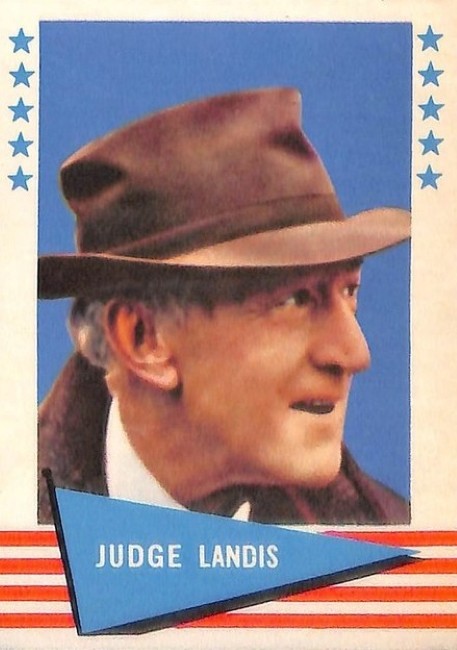
Kenesaw Mountain Landis became baseball’s first Commissioner in 1920. A former federal judge known for his strictness, he took the job with absolute authority – a condition he demanded. He was brought in to clean up the game after the Black Sox Scandal shattered public trust.
Landis made an immediate impact. Though all eight players were acquitted in court, he banned them for life, stating that involvement in game-fixing would never be tolerated. His hardline stance set a precedent that still governs the sport today. Landis remained Commissioner until his death in 1944.
His legacy is complex. He brought stability to the game, but also opposed integration and ruled with an iron hand. Still, his decisive action after the scandal helped preserve the sport’s integrity. For collectors, memorabilia from the Landis era marks the beginning of a new chapter in baseball history – one defined by control, consequence, and a new ethical standard.
Kenesaw Mountain Landis was included in the famed 1961 Fleer set, which depicts dozens of retired players. Despite the set’s popularity, there isn’t a huge market for Landis cards, so high grades are only worth $5-$10. Nonetheless, if you’re assembling a collection of Black Sox baseball cards, you might as well include the man whose judgment changed the sport.
Black Sox Scandal’s Legacy in Baseball Cards
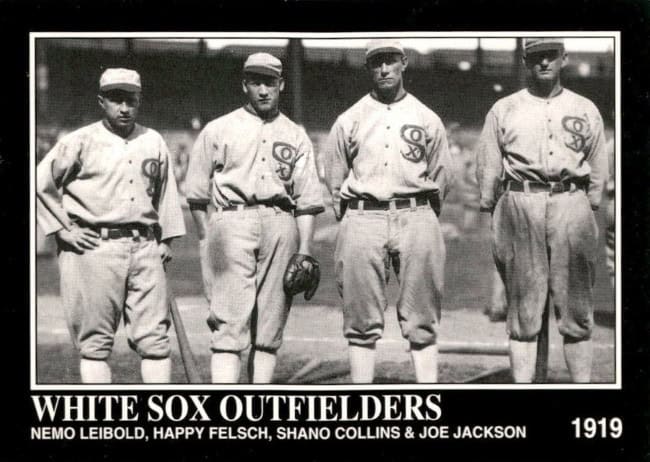
Despite the shame tied to the Black Sox Scandal, the event has fueled interest in related baseball memorabilia for over a century. Items linked to the eight banned players – especially Shoeless Joe Jackson – often command high prices at auction. Collectors are drawn not just to the rarity of these pieces but to the story behind them. From vintage photographs and contracts to World Series programs and autographed balls, artifacts from the 1919 White Sox carry a blend of baseball history and true crime intrigue.
Shoeless Joe remains a central figure in this niche. Though banned from the Hall of Fame, his cards and signatures are among the most sought-after pre-war collectibles. His 1910 Old Mill and 1915 Cracker Jack cards are especially prized. Authentic signatures are even rarer, as Jackson was semi-literate and rarely signed items. Forgeries abound, so serious collectors turn to reputable graders and auction houses to ensure authenticity.
The Black Sox story adds a layer of drama that few other collecting categories can match. It connects fans to one of the most infamous moments in sports history, offering a tangible link to the scandal that nearly destroyed baseball. Whether owned for investment or fascination, these collectibles serve as reminders of how deeply intertwined baseball’s legacy is with its darker chapters.

